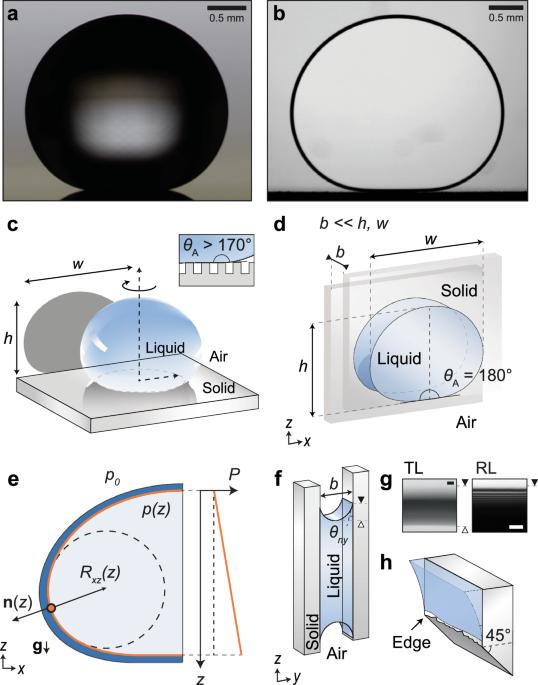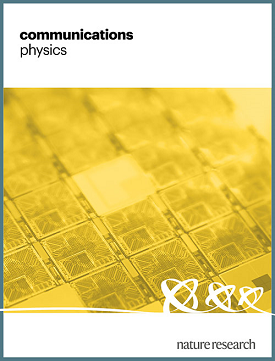准二维伪塞滴
IF 5.4
1区 物理与天体物理
Q1 PHYSICS, MULTIDISCIPLINARY
引用次数: 0
摘要
无梗液滴无处不在,在技术应用中非常重要。虽然人们已经研究过液滴在限制条件下的动力学,但还没有探索过制造尺寸更小的无柄液滴的可能性。在这里,我们展示了轴对称无梗三维(3D)液滴的准二维(Q2D)类比。Q2D 液滴是通过将液体封闭在平行的垂直壁之间,形成受重力影响变形的低纵横比毛细管桥而产生的。静止的 Q2D 液滴采用类似于三维无梗液滴的投影形状,从圆形液滴到水坑不等。移动时,Q2D 液滴表现出与三维液滴概念类似的毛细管和流体机械行为,包括撞击和滑动。当受到外部电场、磁场和流场作用时,Q2D 液滴还表现出更复杂的现象,如悬浮、各种不稳定性和图案形成。三维-二维类比表明,在三维液滴中观察到的各种复杂现象可以在简化的二维几何中进行研究。此外,通过 Q2D 限制类比,还可以探索因尺寸减小和边界条件改变而产生的现象。轴对称无梗液滴在我们身边随处可见,在众多技术应用中也非常重要。作者在此通过实验制备了准二维无梗液滴,并证明它们显示出与传统轴对称无梗液滴相似的许多特征,包括类似的平衡形状、动力学和不稳定性。本文章由计算机程序翻译,如有差异,请以英文原文为准。

Quasi-two-dimensional pseudo-sessile drops
Sessile drops are ubiquitous and important in technological applications. While dynamics of liquid drops have been studied under confinement, the possibility of creating sessile drops with reduced dimensionality has not been explored. Here, we demonstrate a quasi-two-dimensional (Q2D) analogy for axisymmetric sessile three-dimensional (3D) drops. The Q2D drops are created by confining liquids between parallel vertical walls, forming low aspect ratio capillary bridges deformed by gravity. Stationary Q2D drops adopt projected shapes analogous to 3D sessile drops, ranging from circular drops to puddles. When moving, the Q2D drops exhibit capillary and fluid mechanical behaviours conceptually analogous to 3D drops, including impacts and sliding. The Q2D drops also exhibit more complex phenomena such as levitation, various instabilities and pattern formation when subjected to external electric, magnetic and flow fields. The 3D-Q2D analogy suggests that the diverse and often complicated phenomena observed in 3D drops can be studied in the simplified Q2D geometry. Additionally, the Q2D confinement analogy allows exploring phenomena arising from the reduced dimensionality and the altered boundary conditions. Axisymmetric sessile liquid drops are everywhere around us and important in numerous technological applications. Here the authors experimentally prepare quasi-two-dimensional sessile drops and show that they display many similar features as the traditional axisymmetric sessile drops, including analogous equilibrium shape, dynamics, and instabilities.
求助全文
通过发布文献求助,成功后即可免费获取论文全文。
去求助
来源期刊

Communications Physics
Physics and Astronomy-General Physics and Astronomy
CiteScore
8.40
自引率
3.60%
发文量
276
审稿时长
13 weeks
期刊介绍:
Communications Physics is an open access journal from Nature Research publishing high-quality research, reviews and commentary in all areas of the physical sciences. Research papers published by the journal represent significant advances bringing new insight to a specialized area of research in physics. We also aim to provide a community forum for issues of importance to all physicists, regardless of sub-discipline.
The scope of the journal covers all areas of experimental, applied, fundamental, and interdisciplinary physical sciences. Primary research published in Communications Physics includes novel experimental results, new techniques or computational methods that may influence the work of others in the sub-discipline. We also consider submissions from adjacent research fields where the central advance of the study is of interest to physicists, for example material sciences, physical chemistry and technologies.
 求助内容:
求助内容: 应助结果提醒方式:
应助结果提醒方式:


